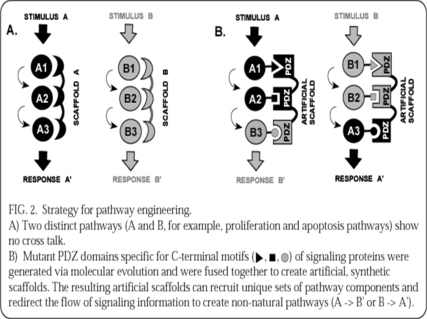Pathway Engineering - to design synthetic scaffolds to artificially change and/or redirect the flow of signaling information in diseased cells.
Signaling specificity can be achieved by the connectivity of a stimulus (A) and a response (A’) that generates a specific input/output relationship (A → A’) . Wiring a correct set of signaling components between input and response is crucial for signaling specificity. Scaffold proteins have been postulated to provide a platform onto which non-covalent interactions between pathway components take place. Under normal condition, mechanisms of specific signaling prevent a cross talk between two unrelated pathways (A and B). However, it would be possible to rewire the signaling information if one can engineer synthetic scaffolds that recruit an non-natural set of components from two unrelated pathways (A → B’). In my previous study, I have shown that a primitive, chimeric scaffold can trigger a signal diversion between two distinct MAPK pathways in yeast.

For signal rewiring, I will attempt to design non-natural, synthetic scaffold proteins that can specifically bind to and reinforce the interactions between signaling components from unrelated pathways to create a novel signaling pathway. I propose to apply this strategy of pathway engineering to diseases caused by signaling defects such as cancer and immune disorders. Specifically, I will target the ERK MAPK pathway (proliferation) and the Bad/Bax pathway (apoptosis) in tumor cells. Using the pathway engineering strategy, I will attempt to shunt proliferation stimuli to apoptotic responses for simultaneous promotion of cell death and suppression of proliferation in a cancer cell.
To design a synthetic scaffold, I will utilize well-studied, modular protein interaction domains such as PDZ and SH3 domains.10 These heterologous interaction domains will be subject to a molecular evolution11 for specificity toward individual signaling components from proliferation and apoptotic pathways. The resulting mutant PDZ domains will be fused together via rational or combinatorial fashion to create a series of synthetic scaffolds that can recruit non-natural sets of signaling proteins from the two pathways (Figure 2B). The putative synthetic scaffolds composed of heterologous interaction modules will be expressed in a cancer cell and be tested for the ability to trigger a apoptotic response upon stimulation by growth factors.
